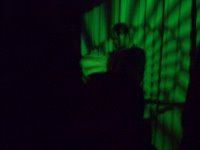The Fan Dancers
This weekend, on both Friday and Saturday night, Andrew and I found ourselves getting home around the time the sun started coming up. This is not necessarily an unusual thing when we decide to have a night out, since Spanish nightlife doesn’t get going until around 2 or 3 in the morning. It was, however, unusual for us to have such a night two nights in a row.
On Friday night, we went to Bikini, a huge club with several rooms, many bars, and an abundance of go-go dancers, both male and female. The male dancers were ridiculously chiseled; they looked like they were wearing sculpted plastic suits. At regular intervals, the scantily-clad dancers would leave the elevated platform, and a single male dancer would make his entrance. He had long black hair and wore a long, black, cassock-like garment with a brooch of sorts at the collar, which, in the strobe light, looked like the visible inch of a priest’s white collar. He began dancing dramatically, interpretively, not in the style you’d imagine would be appropriate for songs like “Funky Cole Medina” (apparently a club favorite) and a slew of Madonna.
By this point it was very late. I wasn’t prepared for the dancing man to suddenly whip out two gigantic fans and begin doing an elaborate, excessively dramatic fan dance, which closely resembled a Gob Bluth magic show on Arrested Development—replete with flashing pink and green lights, strobes, and broad gestures. What the fan dance lacked was camp and irony. It was serious. It was indescribable. He took the stage several times that night and was still writhing with his fans when we finally went home.
On Saturday night, I told one of Andrew’s Barcelona-born friends about the fan dancer; he assured me this was not normal. So I was surprised when, later, at a snug two-story club called Universal, I suddenly found myself being entertained by another fan dancer. This guy was also on an elevated, dramatically lit platform, and he wore a bizarre outfit that consisted of no shirt, what looked like a black tuxedo jacket, and some kind of billowy cravat. He, too, danced interpretively and dramatically with two large fans. Eventually he took his shirt off, but he somehow maintained the seriousness of the dance.
Though these pictures fail to clearly show the fans, they do show two interesting things: first, the dramatic lighting that actually—cleverly!—resembles a fan; and second, the strange incongruity of the single fan-dancer in the corner of this crowded, smoky club.
On Friday night, we went to Bikini, a huge club with several rooms, many bars, and an abundance of go-go dancers, both male and female. The male dancers were ridiculously chiseled; they looked like they were wearing sculpted plastic suits. At regular intervals, the scantily-clad dancers would leave the elevated platform, and a single male dancer would make his entrance. He had long black hair and wore a long, black, cassock-like garment with a brooch of sorts at the collar, which, in the strobe light, looked like the visible inch of a priest’s white collar. He began dancing dramatically, interpretively, not in the style you’d imagine would be appropriate for songs like “Funky Cole Medina” (apparently a club favorite) and a slew of Madonna.
By this point it was very late. I wasn’t prepared for the dancing man to suddenly whip out two gigantic fans and begin doing an elaborate, excessively dramatic fan dance, which closely resembled a Gob Bluth magic show on Arrested Development—replete with flashing pink and green lights, strobes, and broad gestures. What the fan dance lacked was camp and irony. It was serious. It was indescribable. He took the stage several times that night and was still writhing with his fans when we finally went home.
On Saturday night, I told one of Andrew’s Barcelona-born friends about the fan dancer; he assured me this was not normal. So I was surprised when, later, at a snug two-story club called Universal, I suddenly found myself being entertained by another fan dancer. This guy was also on an elevated, dramatically lit platform, and he wore a bizarre outfit that consisted of no shirt, what looked like a black tuxedo jacket, and some kind of billowy cravat. He, too, danced interpretively and dramatically with two large fans. Eventually he took his shirt off, but he somehow maintained the seriousness of the dance.
Though these pictures fail to clearly show the fans, they do show two interesting things: first, the dramatic lighting that actually—cleverly!—resembles a fan; and second, the strange incongruity of the single fan-dancer in the corner of this crowded, smoky club.
Andrew tried to get an explanation from another Spanish friend, who was not surprised or confused by the presence of the fan dancer. “It is difficult,” he said, meaning the intricate splaying and unsplaying of the fans. He explained that it is a traditional dance. He also told us some juicy fan-dancing gossip: this fan dancer used to dance at Bikini but was replaced by the dancer we’d seen the night before. It was all just a little too strange. By this point in the night/morning, my tender, smoke-free New Yorker’s eyes were spasming in the sea of cigarettes, and we soon went home.


Comments